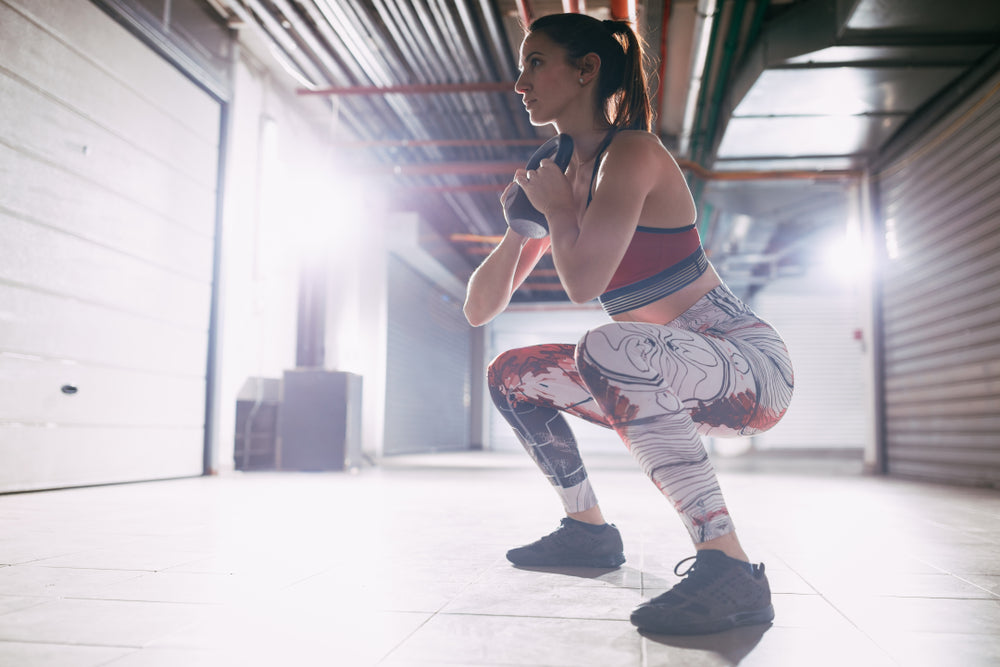Goblet Squat - Squat with Kettlebell

Goblet Squat: For effective training with the kettlebell
In the world of functional training, the goblet squat has established itself as one of the most effective exercises. Especially when combined with a kettlebell, it offers a holistic workout that not only saves space but also targets numerous muscle groups simultaneously. Whether for beginners or advanced users, the goblet squat is versatile and promotes strength, mobility, and stability.
What is a goblet squat?
The goblet squat is a variation of the squat in which a weight—usually a kettlebell or dumbbell—is held in front of the chest. This position promotes an upright posture and also activates the core muscles. Compared to the classic barbell squat, the goblet squat is easier on the joints and easier to perform, especially for beginners.
What are goblet squats good for?
Goblet squats are ideal for building total-body strength, especially in the legs, glutes, and core, as well as improving mobility in the hips, knees, and ankles. Furthermore, posture is optimized by strengthening the back and shoulder muscles. Squats also train functional movements for everyday life, such as lifting objects, and are therefore helpful for getting through everyday life more easily.
Is the goblet squat a squat?
Yes, the goblet squat is a form of squat. However, unlike the traditional barbell squat, the weight is held in front of the chest. This shifts the center of gravity and promotes a more upright posture, reducing strain on the back and increasing core activation.
The effectiveness of different forms of squats depends on individual goals:
- Goblet Squat: Ideal for full-body training, improving posture and mobility.
- Back Squat: Focus on maximum strength development in the legs and buttocks.
- Front Squat: Greater strain on the quadriceps and core muscles.
- Bulgarian Split Squat: One-legged variation to improve balance and leg muscles.
For a balanced workout, it is recommended to combine different squat variations.

How much weight for goblet squat?
The choice of weight depends on the training goal and individual fitness level:
Beginners: Start with 8–12 kg, focus on technique and range of motion.
Advanced: 12–20 kg, to increase strength and muscle mass.
Professionals: 20 kg and more, for maximum strength development and intensity.
It is important that the execution remains clean and the range of motion is fully utilized.
Benefits of the Goblet Squat
1. Full body workout
The Goblet Squat activates various muscle groups:
- Legs: quadriceps, hamstrings, calves.
- Buttocks: Gluteus Maximus and Medius.
- Torso: abdominal muscles, lower back.
- Upper body: shoulders, arms by holding the kettlebell.
2. Improve posture
The frontal load promotes an upright posture, which in the long term leads to better posture in everyday life.
3. Gentle on joints
Compared to other squat variations, the goblet squat is easier on the back because it puts less strain on the spine.
4. Increasing mobility
The deep squat improves mobility in the hips, knees and ankles.
5. Space-saving training
With just one kettlebell you can do an effective workout – ideal for the home gym or on the go.
Kettlebell selection
Classic kettlebells in different weight classes are particularly suitable for the goblet squat:
Kettlebell 8 kg : Ideal for beginners and technical training.
Kettlebell 12 kg : For advanced users who want to combine strength and endurance.
Kettlebell 16 kg and over : For experienced athletes to maximize training intensity.
Our kettlebells feature ergonomic design, non-slip handles, and durable materials—perfect for your workout at home or in the gym.
Conclusion
The goblet squat is a versatile and effective exercise that's ideal for kettlebell training. It promotes strength, mobility, and stability , is gentle on the joints, and requires minimal space and equipment. Whether you're a beginner or a pro, the goblet squat and the high-quality kettlebells from motion sports will take your training to the next level.
You can find more information about kettlebell exercises here .
Note: This blog post is for informational purposes only and is not a substitute for professional training advice. Consult a professional if you have any health concerns.



Leave a comment
All comments are moderated before being published.